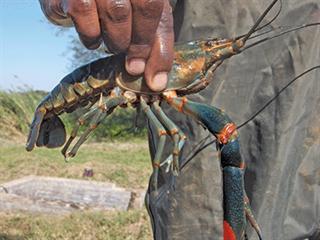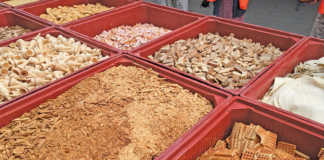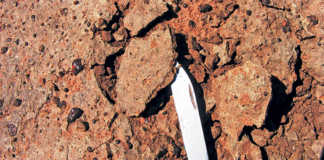
The Redclaw (Cherax quadricarinatus) is a species of freshwater crayfish native to Australia, but an extensive uncultivated population is found in the Nkomazi region of Mpumalanga. Research is now being conducted to determine the viability of producing Redclaw commercially in warm waters in South Africa. The species has evolved to tolerate a relatively high population density and poor quality water. This makes it a highly attractive aquaculture prospect.
Independent researcher Isabel de Winnaar says that if the feral crayfish in Nkomazi could be farmed, this could reduce pressure strain on the ocean-based crayfish stock. Redclaw could also be a cheap protein source and provide employment opportunities. However, legislative restrictions such as the Mpumalanga Nature Conservation Act hinder the utilisation of this species.
“Currently, South African law prohibits commercial farming of Redclaw because it’s considered an invasive, alien species that is apparently a threat to our biodiversity. But we’re consulting with government to change this,” says De Winnaar. “At present Redclaw is being relocated all over the country without any control and we believe that a management plan is needed to handle the species.”
Tolerant of brackish water
Redclaw grow well over a broad temperature range, but optimal growth occurs between 26°C and 29°C. It also shows tolerance to salinity as high as 12ppt (parts per thousand) for extended periods. According to De Winnaar, this is advantageous for commercial production for two reasons.
“Aquaculture in mildly brackish water may be possible and a final purging in saltwater prior to marketing can be performed if market requests it,” she explains.She adds that the Redclaw has a very simple life-cycle and the technology needed to manage this life cycle is correspondingly basic. Brood stock could be sourced from wild stocks and genetic selection and domestication of farm stocks could increase growth rates and yields by as much as 10% per generation.
A disadvantage of freshwater crayfish is their relatively low fertility rate. They produce as few as 300 eggs per spawn, whereas ideal rates are 500 eggs or higher. Redclaw can, however, spawn up to three times a year if the conditions are right. “Through selection, it’s possible to select for higher egg capabilities per individual female,” says De Winnaar.
Under optimal pond conditions, the species can grow from hatching to the smallest marketable size (30g) within four months. Maximum adult size is about 500g.
Feeding
Although Redclaw will tolerate a range of water quality conditions, rapid growth and commercial viability will only be achieved if water quality is managed and maintained within optimal ranges. “Careful record-keeping, a little knowledge of water chemistry or sound advice and some experience are all that’s required,” says De Winnaar. She explains that Redclaw are not fussy eaters. Omnivores, they will consume a variety of organic matter.
“Presently there are no farms feeding complete diets to Redclaw as they do to marine prawns. This is partly because these are not available and because commercial growth can be attained by supplemental feeding. This entails a low-protein, high carbohydrate pellet diet in combination with organic matter,” she explains. The species needs extensive shelter in captivity. Like other crustaceans, it moults or sheds its shell as it grows – and so becomes vulnerable to predation by its pond mates.
“Providing shelter has been shown to improve survival substantially – from 15% with no shelter to 75% for the best shelter types,” says De Winnaar.
Easy to harvest
Harvesting is a simple process that involves a flow trap. An aluminium box is placed in the pond in the late afternoon when the pond is two-thirds empty. The box is located towards the deep end, with a ramp pointing down towards the pond outlet, or where the last of the water will be when the pond drains. An inflow of new water is then introduced via the harvest box that is sensed by the Redclaw. It moves upstream up the ramp and falls into the harvest box, which is aerated to sustain the crayfish until morning.
“This flow trap reduces stress on the animals, maintains them in clean fresh water and results in a healthy premium product for the market. More than 95% of the animals will be caught in this way,” says De Winnaar. Redclaw can be grown at different levels of intensity. “Semi-intensive ponds with relatively high stocking densities (seven to nine crayfish/ m²) will require daily management, whereas less intensive production (under five crayfish/m²) can be managed with lower levels of input,” explains De Winnaar.
She notes that Redclaw are susceptible to many diseases and parasites, but none have been responsible for significant commercial mortalities. However, this is no reason for complacency when controlling the movement of the animals. “In Europe and the Americas, a devastating fungal disease called crayfish plague has caused mortalities in both cultured and wild freshwater crayfish stocks and should be prevented in South Africa,” she warns.
Huge eastern market
Redclaw is regarded as a premium seafood product. “Redclaw can be harvested at any size and can therefore fulfil almost any market. In countries such as Indonesia, Malaysia and Australia, the market for Redclaw is valued at millions of dollars and is considered a good alternative or competitor to the lobster market,” says De Winnaar. “In South Africa, it’s unclear what the market could be, but local sales have been as high as R100/kg.”
She estimates that this country should be able to sustainably produce 2t annually and even more if there is a market uptake. However, she points out that, currently, Redclaw is not sold commercially in South Africa and any sales or even relocation are considered illegal.
Contact Isabel de Winnaar on 072 219 2626 or [email protected].













